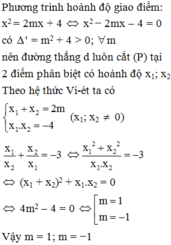Hãy nhập câu hỏi của bạn vào đây, nếu là tài khoản VIP, bạn sẽ được ưu tiên trả lời.

b: Phương trình hoành độ giao điểm là:
\(\dfrac{3}{2}x^2-mx-2=0\)
\(\Leftrightarrow3x^2-2mx-4=0\)
a=3; b=-2m; c=-4
Vì ac<0 nên phương trình luôn có hai nghiệm phân biệt
Theo đề, ta có: \(\left(x_1+x_2\right)^2-3x_1x_2=40\)
\(\Leftrightarrow m^2\cdot\dfrac{4}{9}-3\cdot\dfrac{-4}{3}=40\)
\(\Leftrightarrow m^2\cdot\dfrac{4}{9}=36\)
=>m=9 hoặc m=-9

Phương trình hoành độ giao điểm là :
\(-x^2=mx+2\)
\(\Leftrightarrow x^2+mx+2=0\)
Lại có : \(\Delta=m^2-8>0\)
Theo định lí Vi - et ta có :
\(\left\{{}\begin{matrix}x1+x2=-m\\x1x2=2\end{matrix}\right.\)
\(\left(x1+1\right)\left(x2+1\right)=0\)
\(\Leftrightarrow x1x2+x1+x1+1=0\)
\(\Leftrightarrow2-m+1=0\Leftrightarrow m=3\)
chúng ta sẽ lại có :
Theo định lí Vi - et ta có :
\(\trái(x1+1\phải)\trái(x2+1\phải)=0\)

a) thay x=1,y=5 vao (d):y=2mx+1
5=2m+1\(\Leftrightarrow2m=4\Leftrightarrow m=2\)
vay m=2 thi (d) di qua B(1;5)
b) hoanh do giao diem cua (d) va (P) la nghiem cua phuong trinh
-2x=2mx+1
\(\Leftrightarrow-2x-2mx-1=0\)
\(\left(\Delta\right)=(-2m)^{^{ }2^{ }}-4(-2)(-1)\)
\(\Delta=4m^{2^{ }}-8\)
\(\Leftrightarrow m^2>2\Leftrightarrow m>\mp\sqrt{2}\)
ap dung he thuc vi- et
x1+x2=-m
x1x2=1/2
vi x12+x22+4(x1+x2)=0
(x1+x2)2 -2x1x2 +4(x1+x2)=0
(-m)2-2.1/2+4(-m)=0
m2-1-4m=0
m2-4m-1=0
\(\Delta=20\)
\(\Delta>0\Rightarrow\)phuong trinh co hai nghiem phan biet
m1=\(2+\sqrt{5}\)(tm)
m2=2-\(\sqrt{5}\)tm)
vay m=\(2+\sqrt{5};2-\sqrt{5}\)thi thoa man x12+x22+4(x1+x2)

Lời giải:
PT hoành độ giao điểm:
$x^2-(2mx-2m+1)=0$
$\Leftrightarrow x^2-2mx+(2m-1)=0(*)$
Theo định lý Viet:
$x_1+x_2=2m$
$x_1x_2=2m-1$
$\Rightarrow x_1x_2+1-x_1-x_2=0$
$\Leftrightarrow (x_1-1)(x_2-1)=0$
$\Rightarrow x_1=1$ hoặc $x_2=1$
Nếu $x_1=1$ thì $x_2=2m-x_1=2m-1$
Khi đó:
$x_1^2=x_2-4$
$\Leftrightarrow 1=2m-1-4$
$\Leftrightarrow m=3$ (tm)
Nếu $x_2=1$ thì $x_1=2m-x_2=2m-1$
Khi đó:
$x_1^2=x_2-4$
$\Leftrightarrow (2m-1)^2=1-4=-3<0$ (vô lý)
Vậy.........

b: Phương trình hoành độ giao điểm là:
\(\dfrac{3}{2}x^2-mx-4=0\)
\(\Leftrightarrow3x^2-2mx-8=0\)
ac<0 nên (P) luôn cắt (d) tại hai điểm phân biệt
Theo đề, ta có: \(\left(x_1+x_2\right)^2-3x_1x_2=24\)
\(\Leftrightarrow m^2\cdot\dfrac{4}{9}-3\cdot\dfrac{-8}{3}=24\)
\(\Leftrightarrow m^2\cdot\dfrac{4}{9}=16\)
hay m=6 hoặc m=-6

Lời giải:
a. Để $(d)$ đi qua $A(1;0)$ thì:
$y_A=2x_A-m+3$
$\Leftrightarrow 0=2.1-m+3=5-m$
$\Leftrightarrow m=5$
b.
PT hoành độ giao điểm:
$x^2-(2x-m+3)=0$
$\Leftrightarrow x^2-2x+m-3=0(*)$
Để $(P), (d)$ cắt nhau tại 2 điểm pb thì $(*)$ phải có 2 nghiệm pb $x_1,x_2$
Điều này xảy ra khi:
$\Delta'=1-(m-3)>0\Leftrightarrow 4-m>0\Leftrightarrow m< 4$
Áp dụng định lý Viet: $x_1+x_2=2$ và $x_1x_2=m-3$
Khi đó:
$x_1^2-2x_2+x_1x_2=-12$
$\Leftrightarrow x_1^2-(x_1+x_2)x_2+x_1x_2=-12$
$\Leftrightarrow x_1^2-x_2^2=-12$
$\Leftrightarrow (x_1-x_2)(x_1+x_2)=-12$
$\Leftrightarrow x_1-x_2=-6$
$\Rightarrow x_1=-2; x_2=4$
$m-3=x_1x_2=(-2).4=-8$
$\Leftrightarrow m=-5$ (tm)
